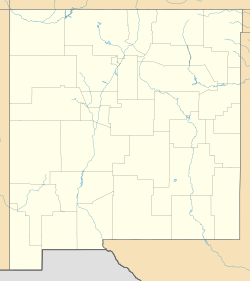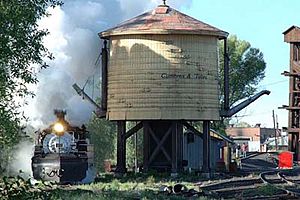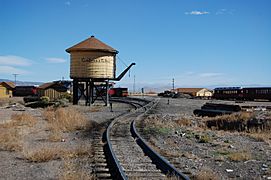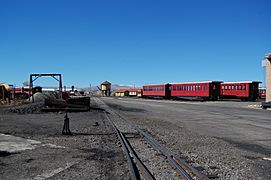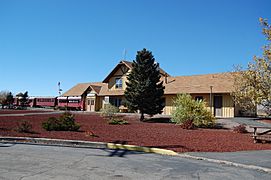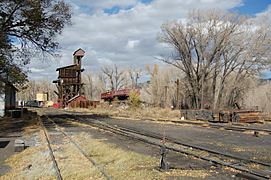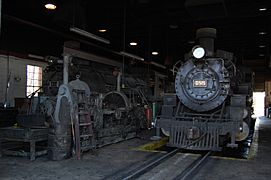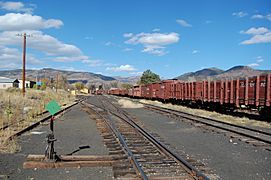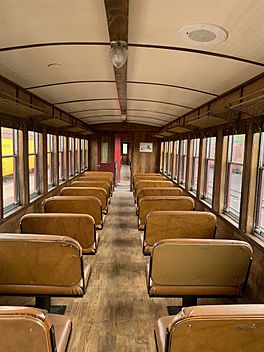Cumbres and Toltec Scenic Railroad facts for kids
 |
|
| Overview | |
|---|---|
| Headquarters | Chama, New Mexico |
| Reporting mark | C&TS |
| Locale | Conejos County and Archuleta County in Colorado and Rio Arriba County in New Mexico, United States |
| Dates of operation | 1970–present |
| Technical | |
| Track gauge | 3 ft (914 mm) |
| Length | 64 mi (103 km) |
| Other | |
| Website | |
|
Denver & Rio Grande Railroad
San Juan Extension |
|
 |
|
| Nearest city | Antonito, Colorado, and Chama, New Mexico |
| Area | 1,430 acres (5.8 km2) |
| Built | 1880 |
| Architect | Denver and Rio Grande Western Railroad Baldwin Locomotive Works |
| Architectural style | Late 19th And Early 20th Century American Movements |
| MPS | Railroads in Colorado, 1858-1948 MPS |
| NRHP reference No. | 73000462 (original) 07000374 (increase) |
| Significant dates | |
| Added to NRHP | February 16, 1973 |
| Boundary increase | April 24, 2007 |
| Designated NHLD | October 16, 2012 |
The Cumbres and Toltec Scenic Railroad, often called the C&TSRR, is a special old train line. It uses a 3 ft (914 mm) narrow-gauge track. This means the tracks are closer together than regular train tracks.
The railroad runs for 64 miles (103 km) between Antonito, Colorado, and Chama, New Mexico. It's named after two important places along its route: the high Cumbres Pass (which is 10,015-foot (3,053 m) tall) and the deep Toltec Gorge.
This train line was once part of the Denver and Rio Grande Western Railroad's narrow-gauge system. Since 1970, the states of Colorado and New Mexico have owned it together. The C&TSRR is one of only two parts of the old D&RGW narrow-gauge network that still exists. The other is the Durango and Silverton Narrow Gauge Railroad.
The C&TSRR has ten narrow-gauge steam locomotives. Five of these are currently working. It also has two narrow-gauge diesel locomotives. Sometimes, two smaller steam locomotives, Nos. 315 and 168, are used for special trips.
Contents
History of the Cumbres & Toltec Scenic Railroad
On February 20, 1880, workers for the Denver and Rio Grande Railway (D&RG) started building the San Juan Extension. They laid the first tracks south from Alamosa, Colorado, to Antonito, Colorado. They arrived in Antonito in March 1880.
The company chose a narrow track width of three feet. This was because narrow-gauge tracks were cheaper to build. They could also make sharper turns, which was helpful in mountain areas. From Antonito, the line continued west to Chama, New Mexico, reaching it on December 31, 1880. The track covered 64 miles (103 km), went through two tunnels, and crossed a 10,015-foot (3,053 m) mountain pass. It also went along a 600-foot deep gorge. The main goal of this line was to reach the valuable minerals near Silverton, Colorado.
When the railroad reached Chama, other companies started using the local forests. This led to a busy logging business in the town. Lumber mills near Chama provided steady income for the railroad. This lasted until the late 1960s.
After World War II, there was an oil boom in Farmington, New Mexico. This brought a lot of money to the railroad. Trains with 60 cars of pipes traveled west from Antonito. Oil from the Gramps Oil Fields in southern Colorado was also shipped from Chama to Antonito. The lumber mills also continued to provide income. This increase in business helped save the train line from being closed down.
Challenges of Cumbres Pass
The high Cumbres Pass was a big challenge for the railroad. It is 10,015 feet (3,053 m) above sea level. This high elevation often caused severe snowstorms. To deal with the snow, the railroad bought "rotary snowplows." These giant machines used a spinning blade to clear snow from the tracks. Rotary OM and Rotary OY were used on the Cumbres Pass line. Both are still in Chama, New Mexico.
Every few years, Cumbres Pass could get as much as 500 inches of snow. These snowstorms were very expensive for the railroad. The "Granddaddy of All Snowstorms" happened in the winter of 1951–1952. This was the worst winter ever recorded on the line. It was a major reason why the railroad considered closing the line in the 1960s.
In September 1968, the Denver and Rio Grande Western Railroad decided to close its narrow-gauge lines. But in April 1969, New Mexico passed a law to buy the track between Chama and Antonito. Colorado passed a similar law in 1970. The two states then owned the line together. By 1971, the Cumbres and Toltec Scenic Railroad was created.
Notable Events on the Line
2002 Closures
In 2002, the C&TSRR had to close twice. First, in the spring, it closed to fix problems with the track bed. Then, in the summer, trains stopped running because of dangers from wildfires.
Lobato Trestle Fire
On June 23, 2010, a fire badly damaged Lobato Trestle. This is a bridge about four miles (6.4 km) east of Chama. While the bridge was being fixed, trains from Chama ran limited services. Trains from Antonito only went to Osier and back. The bridge was fully repaired and reopened on June 20, 2011.
National Historic Landmark Status
In 1973, the Cumbres and Toltec Scenic Railroad was added to the National Register of Historic Places. Its protected area was made larger in 2007. In 1976, the American Society of Civil Engineers named it a National Historic Civil Engineering Landmark.
Finally, in 2012, the railroad became a National Historic Landmark. This was because of its amazing engineering, its well-preserved tracks and equipment, and its important role in developing the region it served.
How the Railroad Operates Today
The Cumbres and Toltec Scenic Railroad runs from late May to late October. Each morning, two trains leave, one from Antonito, Colorado, and one from Chama, New Mexico. Both trains meet at Osier, Colorado, for lunch. Passengers eat in a modern dining hall.
After lunch, passengers can continue to the other end of the line. Or, they can switch trains and go back to where they started. When the train going west reaches Cumbres Pass, passengers can take a bus back to Antonito. Or they can continue into Chama. Hikers on the continental-divide trail can also get a ride down the mountain from the pass. At the end of the day, buses are available for passengers who traveled from the opposite end. The bus ride takes about an hour.
Besides the regular trips, the C&TSRR also has special events. These include dinner trains. During the holiday season, there are "Santa Trains" from Chama and Antonito. Guests are encouraged to bring gifts or food for people in need.
Managing the Railroad
After the C&TSRR started in 1971, a special group called the Cumbres and Toltec Scenic Railroad Commission was formed. This group hired other companies to run the trains. In 2012, the Commission decided to run the railroad itself. They created Cumbres and Toltec Operating LLC. John Bush, who had worked for the railroad for a long time, became president on December 13, 2012. He retired on November 14, 2020.
Friends of the C&TSRR
In 1988, a nonprofit organization called the Friends of the Cumbres and Toltec Scenic Railroad was created. Their goal is to help preserve the railroad's history. They also help maintain the tracks and trains. The Friends group also runs education programs. They provide guides, called docents, who tell passengers interesting facts about the railroad and its history.
Route Description
Places Along the Line
- Chama, New Mexico 36°54′N 106°35′W / 36.900°N 106.583°W
- Cumbres Pass 37°1′N 106°27′W / 37.017°N 106.450°W
- Osier, Colorado 37°1′N 106°20′W / 37.017°N 106.333°W
- Toltec Gorge, New Mexico 36°59′N 106°18′W / 36.983°N 106.300°W
- Sublette Station 36°59′N 106°14′W / 36.983°N 106.233°W
- Antonito, Colorado 37°4′N 106°1′W / 37.067°N 106.017°W
From Chama to Osier
Chama Yard
The Chama yard is where the railroad keeps most of its freight cars. It also stores the two rotary snowplows, Rotary OY and Rotary OM. Part of the original roundhouse from the D&RGW is still there. A fire burned most of it years ago. What's left is used for storage. Locomotive No. 497 is currently stored here.
On the other side of the old roundhouse are the shops. This is where engines are fixed and prepared for their trips. The shops have two stalls and can hold two engines at once. On the west side of the yard is the original train station from the late 1800s. You can buy train tickets and find a gift shop there. Over 100 freight cars are in the yard, and about 40 of them can still be used. The yard is open for visitors to explore.
From Chama, the train goes northeast, crossing the Rio Chama river. About one mile (1.6 km) later, the railroad starts climbing a mountain. The first stop is Lobato (MP: 339.99). Here you can see parts of an old animal pen and a water tank. This tank was built for a movie in the 1980s. It was later used in Indiana Jones and the Last Crusade. The water tank fell over in 2006 due to age and strong winds.
Lobato Trestle is also at Lobato. It's the second-highest bridge on the line, built in 1883. Only one locomotive can cross it at a time because of its weight limits. So, if two engines are pulling a train, they have to separate and rejoin on the other side. The bridge was rebuilt in 2011 after a fire almost destroyed it.
From Lobato to Cumbres, the train runs on the north side of Wolf Creek. There are several old stations along the way. The first is Dalton (MP: 335.5), where only the station sign remains. Next is Cresco Siding and a water tank (MP 335.5). Just before this, the track crosses into New Mexico for the first time. This water tank is used for smaller engines and rotary snowplow trains.
The route then enters a small canyon past Hamilton's Point. After leaving the canyon, the track turns northwest and goes up Wolf Creek through Coxo. At Coxo, there's a short side track for maintenance equipment and a station sign. At a narrow part of the valley, the track makes a horseshoe turn up to Windy Point. At Windy Point, the wind blows so strongly that smoke from the trains often blows forward instead of backward. This spot is less than a quarter of a mile from Cumbres Pass.
At Cumbres (MP 330.60), which is 10,015 ft (3,053 m) high, you'll find the Car Inspector's House and a Water Standpipe. There are also remnants of a large snow shed and the Section House. Cumbres is the highest point on the railroad. It's also the highest point of any narrow-gauge railroad in North America. When the engine reaches the pass, it needs to refill its water tank. It uses about three-quarters of its water supply to get up the mountain. After getting water and a quick brake check, the train heads east and starts going downhill.
At "Tanglefoot Curve," the track loops back on itself to lose elevation slowly. Here, trains going downhill will do a "boiler blowdown." This is when the engine releases steam to clean out dirt from the bottom of the boiler. From there, the track turns north up the Los Piños Valley.
The track continues a gentle downhill slope to the north until it reaches Los Piños tank. This tank is always full and is used for small engines and rotary trains. The track then makes a gentle loop to the west and comes back east at Los Piños station (MP: 324.8). There's only a side track and the station sign here. The track then turns north again towards Osier, Colorado. Just before Osier, at Milepost 320, the track crosses Cascade Trestle. This is the highest bridge on the entire line, sitting 137 ft (42 m) above the river below. The train then stops at Osier, Colorado (MP: 318.40), where passengers enjoy lunch in a modern indoor building.
From Antonito to Osier
This section covers the eastern part of the line. It goes from the small town of Antonito to Osier, which is the middle point of the line.
Antonito (MP 280.70) is a small town that was important for the old railroad. It's home to the C&TSRR car shop, a water tank, and other old railroad items. Most of these buildings were built by the C&TSRR. This is because the original rail yard and station were not sold to Colorado and New Mexico.
Soon after leaving the station, the train goes straight for three miles (4.8 km). Then it enters some hills. Shortly after, the train crosses Ferguson's Trestle (MP 285.87). The original bridge was in a 1988 TV movie called Where the ... Gold?. During filming, an explosion accidentally burned down the bridge. Trains stopped for a week while the C&TSRR built a temporary bridge. The next winter, the bridge was rebuilt to look like the original.
About three miles (four point eight kilometres) later, the train crosses into New Mexico for the first of 11 times. It then climbs a ledge up to a lava mesa. At Lava (291.55), you can see the old water tank from Antonito, which was moved here in 1971. The track goes around a horseshoe curve. This curve is also used to turn the rotary snowplow trains from Chama.
Heading west, the track goes around Whiplash Curve, which is a double-horseshoe curve. About one mile (1,600 m) from Whiplash Curve are the side tracks and wye at Big Horn. A wye is a Y-shaped track used to turn trains around. Past Big Horn, the train loops around the sides of mountains. It goes through more horseshoe curves before reaching the first water stop at Sublette.
Sublette is an abandoned railroad camp. It has a log bunk house, a section house, a side track, and other buildings. There used to be a water tank at the west end of the side track. Today, there is a standpipe in its place. After the train's water tank is filled, the train slowly moves into beautiful aspen groves.
After Sublette is Toltec Siding. In the 1950s, this was where oil pipe trains met. These trains moved oil between Chama and Farmington to Alamosa. Soon after, trains go through Mud Tunnel. This tunnel is special because it's lined with wooden pillars. This is because it was dug through soft volcanic ash. If the wooden beams in the tunnel collapsed, the D&RGW would build a temporary bypass track. This allowed passengers and small cars to go around the tunnel to another waiting train. After this, trains pass around Phantom Curve and through Calico Cut. Then they slow down when entering the longer Rock Tunnel. Trains exit this tunnel into Toltec Gorge. Here, the track is 600 ft (180 m) above the river. The line then follows the river to Osier.
- Line's terminus in Antonito
-
The entrance to the C&TS yard in Antonito, October 2012
-
The station and shed in Antonito, October 2012
-
The water tower in Antonito, October 2012
-
The yard in Antonito, October 2012
-
The station building in Antonito, October 2012
- Line's terminus in Chama
-
The coaling tower in Chama, October 2012
-
The water tower in Chama, October 2012
-
The shop in Chama, October 2012
-
The yard in Chama, October 2012
-
The depot in Chama, October 2012
Trains and Cars
| Number | Type | Wheel Arrangement | Classification | Builder | Built | Serial Number | Former | Status | In Service | Anticipated Return to Service Date |
|---|---|---|---|---|---|---|---|---|---|---|
| 463 | Steam | 2-8-2 | K-27 | Baldwin Locomotive Works | 1903 | 21788 | Denver and Rio Grande Western Railroad | Operational | Yes | N/A |
| 483 | Steam | 2-8-2 | K-36 | Baldwin Locomotive Works | 1925 | 58584 | Denver and Rio Grande Western Railroad | Display, undergoing cosmetic restoration | No | N/A |
| 484 | Steam | 2-8-2 | K-36 | Baldwin Locomotive Works | 1925 | 58585 | Denver and Rio Grande Western Railroad | Operational | Yes | N/A |
| 487 | Steam | 2-8-2 | K-36 | Baldwin Locomotive Works | 1925 | 58588 | Denver and Rio Grande Western Railroad | Operational | Yes | N/A |
| 488 | Steam | 2-8-2 | K-36 | Baldwin Locomotive Works | 1925 | 58589 | Denver and Rio Grande Western Railroad | Operational | Yes | N/A |
| 489 | Steam | 2-8-2 | K-36 | Baldwin Locomotive Works | 1925 | 58590 | Denver and Rio Grande Western Railroad | Operational | Yes | N/A |
| 492 | Steam | 2-8-2 | K-37 | Baldwin Locomotive Works Burnham Shops |
1928 | 20749 | Denver and Rio Grande Western Railroad | Under restoration | No | Unknown Date |
| 494 | Steam | 2-8-2 | K-37 | Baldwin Locomotive Works Burnham Shops |
1928 | 20748 | Denver and Rio Grande Western Railroad | Static display | No | N/A |
| 495 | Steam | 2-8-2 | K-37 | Baldwin Locomotive Works Burnham Shops |
1928 | 20522 | Denver and Rio Grande Western Railroad | Static display | No | N/A |
| 497 | Steam | 2-8-2 | K-37 | Baldwin Locomotive Works Burnham Shops |
1930 | 20521 | Denver and Rio Grande Western Railroad | Stored, awaiting overhaul | No | Unknown Date |
| 15 | Diesel | (B-B) | 47-Ton (Center-Cab) | General Electric (GE) | 1943 | 27538 | Oahu Railway and Land Company, Georgetown Loop Railroad |
Operational | Yes | N/A |
| 19 | Diesel | (B-B) | 47-Ton (Center-Cab) | General Electric (GE) | 1943 | 27539 | Oahu Railway and Land Company | Operational | Yes | N/A |
| 168* | Steam | 4-6-0 | T-12 | Baldwin Locomotive Works | 1883 | 6670 | Denver and Rio Grande Railroad | Operational | Yes | N/A |
| 315* | Steam | 2-8-0 | C-18 | Baldwin Locomotive Works | 1895 | 14352 | Florence and Cripple Creek Railroad, Denver and Rio Grande Western Railroad |
Operational | Yes | N/A |
* No. 168 is owned by the City of Colorado Springs, Colorado. No. 315 is owned by the Durango Railroad Historical Society. Both locomotives are stored and serviced at the C&TSRR through agreements with their respective owners and used on special excursions, hence their inclusion on this roster.
Steam Locomotives
All the steam locomotives on the C&TSRR used to belong to the Denver and Rio Grande Western Railroad. The railroad has three types of steam locomotives. The K-27, K-36, and K-37 engines are all "Mikado" engines. They have a 2-8-2 wheel arrangement and were built by Baldwin Locomotive Works. As of 2023, five of the ten steam locomotives are working: Nos. 463, 484, 487, 488, and 489.
Locomotive 497, a K-37 type, was fixed up in 1984 for the Durango and Silverton Narrow Gauge Railroad. It was traded to the C&TSRR in 1991 for locomotive 482. Locomotive 497 stopped working in 2002 and is now stored in the Chama roundhouse. It is waiting to be fixed. In February 2022, the railroad announced they would check locomotives 492 and 497 to see which one was easier to restore. Locomotive 492 was chosen. In August 2023, locomotive 492 was moved into the Chama roundhouse to begin its restoration. The C&TSRR is fixing locomotive 492 to burn coal. It will also temporarily use locomotive 497's tender (the car that carries coal and water) behind locomotive 492.
In October 2019, locomotive 489, a K-36 type, was taken out of service for a required inspection. Work stopped in March 2020 due to the COVID-19 pandemic. Work restarted in October 2020. In December 2020, the railroad decided to change locomotive 489 to burn oil instead of coal. This was done to help the railroad run in different environmental conditions. The change was finished in June 2021, just in time for the 2021 season. In August 2022, the railroad announced that locomotive 487 would also be changed to burn oil during the winter of 2022-2023.
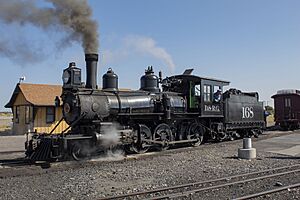

The T-12 No. 168 is a "Ten Wheeler" type engine. It has a 4-6-0 wheel arrangement and was also built by Baldwin Locomotive Works. This is the oldest steam locomotive that the railroad operates. It was fully restored in October 2019. It now runs on special trips for the C&TSRR.
Another engine that runs on the railroad is D&RGW No. 315. No. 315 is a "Consolidation" type locomotive. It has a 2-8-0 wheel arrangement. It is owned by the Durango Railroad Historical Society. But it is on loan to the C&TSRR until at least 2025. No. 315 was restored in August 2007. It continues to run on special trips for both the D&SNG and the C&TSRR. After the 2021 season, No. 315 was temporarily taken out of service for a required inspection. It returned to service on March 8, 2023.
Diesel Locomotives
The C&TSRR has two General Electric 47-ton diesel locomotives. They were built in 1943. These are Nos. 15 and 19. They are used for emergencies when the steam locomotives are not working. They are also used for operations outside the regular season. Both came from the Oahu Railway and Land Company. No. 19 was bought by the C&TSRR in 1972 and is in Antonito. No. 15 was leased by the Georgetown Loop Railroad in the early 1990s. It was bought in 2013 and is in Chama. In November 2023, the C&TSRR got another diesel locomotive, a Bombardier-built DL-535E, from the White Pass & Yukon Route.
Rotary Snowplows
The C&TSRR owns two ALCO steam-powered rotary snowplows: Rotary OY and Rotary OM. Rotary OM was bought in the late 1800s by the D&RGW. It has been used on the line ever since. It has not run since the 1970s because of mechanical problems. Rotary OY was built by ALCO in the 1920s. It has been used in several places on the line. It last ran in late winter of 2020 to celebrate the 50th anniversary of the C&TSRR. There are no plans to run it again soon, but it is in good condition and works.
D&RGW No. 168 Restoration
In 2016, D&RGW No. 168 arrived in Antonito. It came from Colorado Springs, Colorado, to be restored. The engine had been on display in a public park for a long time. It was in good condition. Restoration began in March 2017 and finished in October 2019. The project was led by the Cumbres and Toltec Special Projects department. It cost $508,000 and took 27 months. The railroad plans to use this engine often for regular excursion service. As of 2023, No. 168 continues to operate on special trips for the C&TSRR.
Passenger Cars
For passengers, the C&TSRR uses different types of cars. Some have flat roofs, and others have clerestory roofs (raised sections with windows). The interiors match the railroad's three classes of service: Coach, Deluxe (which used to be called Tourist class), and Parlor. In 2019, the car shop in Antonito, Colorado, finished building the first of new clerestory cars. These will be used as standard passenger cars and new Parlor cars. This is part of a plan to replace the older flat-roofed cars because they are getting old. The C&TSRR also has open-air gondolas for viewing. They also have special coaches that are wheelchair-friendly and have snack areas.
Typical Train Setup
A normal C&TSRR train usually includes:
- 1 K-27, K-36, or K-37 2-8-2 steam locomotive. Sometimes a second locomotive is added if the train is long.
- 3 Coach cars (sometimes more are added if many people are riding).
- 1 ADA/Concession coach (for wheelchairs and snacks).
- 1 Observation gondola (open-air car).
- 1 Deluxe class coach.
- 1 Parlor class coach.
Freight Cars
The Cumbres and Toltec Scenic Railroad also has many old D&RGW narrow-gauge freight cars. These are used for display and for special trips that show what old trains were like.
See also
- D & RG Narrow Gauge Trestle
- List of Colorado historic railroads
- List of Denver and Rio Grande Western Railroad lines
- List of heritage railroads in the United States
- Narrow-gauge railroads in the United States
- San Juan Express
- National Register of Historic Places listings in Colorado § Archuleta County
- National Register of Historic Places listings in Conejos County, Colorado
- National Register of Historic Places listings in Rio Arriba County, New Mexico
- List of National Historic Landmarks in Colorado
- List of National Historic Landmarks in New Mexico



